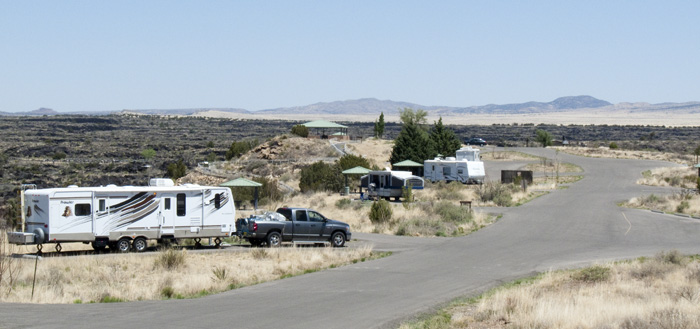Valley of Fires Recreation Area, Carrizozo NM

Valley of Fires campground looking north from site 15, April 27, 2009
Valley of Fires Recreation Area and campground
Valley of Fires is a BLM Recreation Area in south central New Mexico.
Here's an excerpt from the BLM website description of the Valley of Fires Recreation Area
Valley of Fires recreation area is located immediately adjacent to the Malpais Lava Flow. Approximately 5,000 years ago, Little Black Peak erupted and flowed 44 miles into the Tularosa Basin, filling the basin with molten rock. The resulting lava flow is four to six miles wide, 160 feet thick and covers 125 square miles. The lava flow is considered to be one of the youngest lava flows in the continental United States.
From a distance, Valley of Fires appears as barren rock but when you walk through the nature trail there are many varieties of flowers, cactus, trees and bushes typical of the Chihuahuan desert. Animals include bats, roadrunners, quail, cottontails, mule deer, barberry sheep, and lizards. It's also a virtual birdwatcher's paradise with great horned owls, burrowing owls, buzzards, hawks, gnat catchers, cactus wrens, sparrows and golden eagles.
Camping
The recreation area has 19 campsites with picnic shelters, tables, grills, and potable water at each site. RV electric hookups are available at 14 sites. Two sites are wheel chair accessible. The full facility bathroom is fully accessible and has showers. Vault toilets are available throughout the park.
Valley of Fires Recreation Area, Carrizozo NM
- This is a quiet, well maintained BLM campground with paved sites, some with electric & water
- There is good biking on the park roads
- Good Verizon cell phone service
- Good Verizon EVDO service
- Find other references to Valley of Fires
- List the nights I've camped here
- Go to Valley of Fires website
- Get a BLM map
- Check the weather
Nights I've camped here
What a Real Essay Is
... An essay is something you write to try to figure something out.